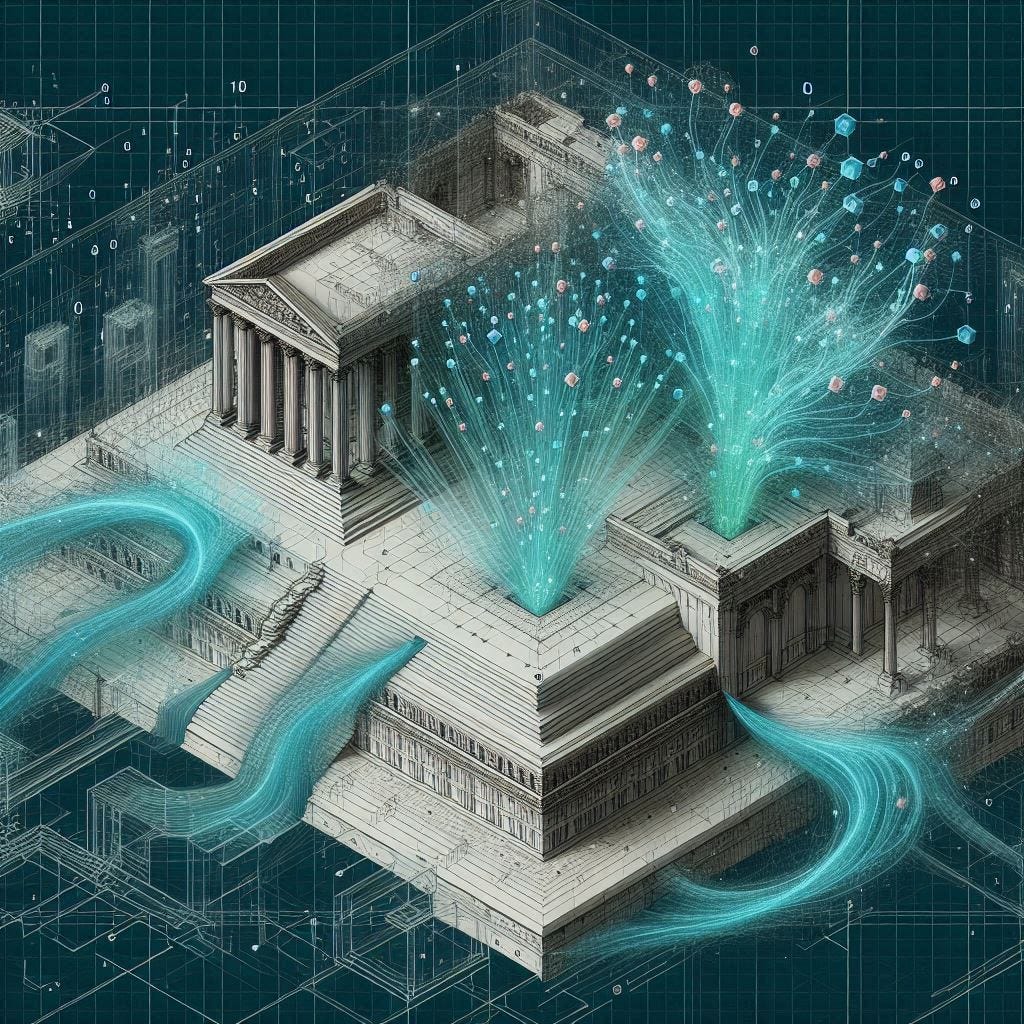In her work "The Human Condition," Hannah Arendt explores the fundamental relationship between citizens and society. She particularly illuminates how the ancient Greek polis was built on a self-governing constitution where laws were formed through dialogue and agreements for the common good. Arendt discusses the basic conditions of human activity - our actions, labor, and work - and how these shape society's structure and the human condition.
The Social Contract and Its Machinery
Thomas Hobbes (in Leviathan, 1651) describes how we as citizens voluntarily relinquish parts of our natural freedom for the common good by submitting to society's laws. This creates the formalization that gives society's institutions their legitimate power.
This "social contract," later developed by thinkers like Rousseau, is not a historical description but a philosophical model for understanding society's foundations. It helps us comprehend how what began as simple agreements between citizens has evolved into an extensive machinery of institutions, bureaucracies, and technological systems.
When I first encountered Arendt's work, I was struck by how fundamentally the theme of human and machine is rooted in these formalized agreements - dialogues transformed into societal structures. As citizens in a democracy, we relinquish parts of our natural freedom for the common good, and it is through this silent agreement that society's institutions derive their legitimate power.
In our daily lives, this becomes almost invisible - we take these structures for granted without reflecting on their origins. However, in my work as a social worker, this social contract becomes highly tangible, particularly when confronting criminality or social regulations. When I meet clients who question drug legislation, for instance, we need not enter into a discussion about the merits of the substances themselves. Rather, it's about our participation in a contract as citizens - even though we never actively signed it. If one wishes to change the terms of this contract, it must occur through democratic processes: by raising the issue, gaining political attention, and driving change through our democratic institutions. But that discussion about the role of politics is a topic for a later chapter.
Growing Complexity
Over the centuries, this societal machinery has grown in complexity. Each generation has added new layers of rules, institutions, and technologies, often in response to new challenges or as attempts to correct flaws in previous systems. The result is a network of interconnected systems so complex that no single person can grasp its entirety.
This complexity manifests itself in welfare systems across the globe, where multiple governance levels interact with various frameworks, guidelines, and digital tools. While the specific structures differ between countries, the fundamental challenge remains: how to maintain human judgment within increasingly systematized welfare services.
As an actor within this "machine," I've experienced firsthand how the system becomes virtually impossible to fully comprehend. Take child welfare investigations as an example: social workers must simultaneously navigate national legislation, regional guidelines, standardized assessment frameworks, extensive documentation requirements, and an array of digital tools. Each component serves a purpose, yet together they create a labyrinth of requirements that can sometimes overshadow the very human encounters they're meant to support.
Yet, understanding the democratic foundations of these systems brings both responsibility and opportunity. As professionals, we have an obligation to highlight risks and shortcomings - both within our organizations and through public debate. Beyond this blog, I've contributed to this discussion through various opinion pieces. However, my aim isn't merely criticism. I strive for critical reflection - analytical thinking that acknowledges both challenges and possibilities.
I believe understanding our historical trajectory is crucial. How did we arrive at this level of complexity? What were the intentions behind each added layer? History isn't just interesting; it's instructive. At the same time, we must strive for a holistic perspective while acknowledging the paradox that modern society increasingly demands specialists and experts.
It is in this meeting between human and machine that our shared society now takes shape, where the social worker becomes the bridge between system and citizen - a role that demands both specialized knowledge and the ability to see beyond individual components to the larger whole.
The Modern Dilemma
The landscape of contemporary welfare work reveals itself as increasingly complex, characterized by the continuous interplay between different organizational realities and knowledge forms. Rather than operating in isolation, today's welfare professionals find themselves navigating between three distinct but interconnected spheres, each with its own logic, demands, and ways of understanding reality.
At the heart of welfare work lies the Professional Sphere, where practitioners engage directly with clients through face-to-face encounters. This is where theoretical knowledge transforms into practical wisdom, where ethical judgments shape daily decisions, and where the true complexity of human situations demands both expertise and empathy. It's in this sphere that social workers develop their tacit knowledge - that deep, experiential understanding that often proves difficult to articulate but remains essential for quality practice.
Surrounding and intersecting with this professional core, we find the Administrative Sphere - the formal structures and systems that organize and govern welfare work. Here, legal frameworks meet documentation requirements, standardized methods encounter resource constraints, and professional judgment faces accountability demands. While sometimes perceived as constraining, these administrative structures also provide the necessary framework for ensuring equity, legal security, and systematic quality development.
Encompassing both these spheres is the Knowledge Development Sphere, where different forms of understanding are created, validated, and transformed. This is where research evidence meets practice-based insights, where method development encounters local innovations, and where professional learning takes shape through the continuous integration of new knowledge with practical experience.
The dynamic interaction between these spheres creates both challenges and opportunities. When a social worker implements a standardized assessment tool, they're not simply following a procedure - they're actively mediating between research-based knowledge, administrative requirements, and the unique needs of the individual client. This complex translation process demands both systematic understanding and professional artistry.
These spheres don't just coexist - they actively shape and transform each other. Administrative systems influence how professionals work with clients, while practical experiences from the field gradually reshape both administrative procedures and our understanding of what constitutes valid knowledge. Similarly, new research findings and methodological developments influence both administrative systems and professional practice, creating a continuous cycle of mutual influence and adaptation.
Understanding these interactions helps us grasp why seemingly simple implementations - like introducing a new assessment method or documentation system - often prove surprisingly complex. Each change must be translated and integrated across all three spheres, requiring careful attention to both formal structures and informal practices, to both explicit guidelines and tacit knowledge.
The challenge facing modern welfare work isn't to choose between these spheres but to find ways of integrating them that preserve and enhance the essential human elements of practice while benefiting from systematic approaches and evidence-based knowledge. This requires a deep understanding of how different forms of knowledge and practice can complement rather than compete with each other, and how systems can be designed to support rather than constrain professional judgment.
Professions within the Machinery
Social work exemplifies how modern welfare professions operate at the intersection of multiple knowledge and practice spheres. As a relatively young profession still developing its identity, it illustrates the complex dynamics of contemporary welfare work through three fundamental spheres:
The Professional Sphere encompasses direct client engagement requiring sophisticated judgment. Here, practitioners develop what Aristotle called phronesis - practical wisdom for navigating uncertain situations and making sound decisions in unique cases.
The Administrative Sphere presents standardized processes and formal procedures. Rather than mere bureaucracy, these represent society's attempts to ensure equity and accountability while maintaining professional autonomy.
The Knowledge Development Sphere requires continuous integration of new research, methods, and best practices through active participation in knowledge development and practice-based learning.
Social workers must constantly navigate between these spheres with "professional artistry" - weaving together different forms of knowledge to serve client needs. This demands:
Translation between knowledge forms
Balancing competing priorities
Judging when to use standardized approaches versus professional judgment
Meaningful documentation that satisfies requirements while capturing complexity
The challenge lies in how these spheres operate on different logics and timelines. While administration demands immediate documentation, building client trust requires patience. Where standard processes suggest clear paths, complex human situations often need creative solutions.
Yet this complexity makes social work a rich example of modern professional practice. Its development isn't just about new methods - it's about sophisticated integration of knowledge forms in service of human welfare, combining systematic knowledge with practical wisdom.
This is the second post in a series exploring the relationship between humans and the systems we have created. Feel free to follow this journey by subscribing to the blog.






